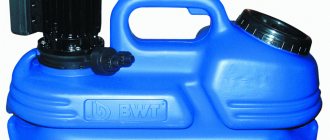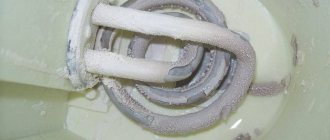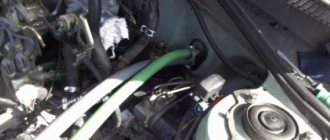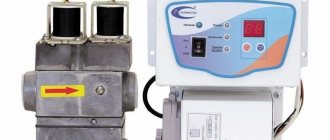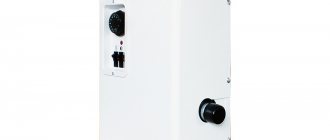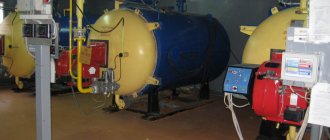- Do you hear dull knocks, noise, or crackling noises when the boiler heats up?
- Has the hot water pressure dropped in the kitchen and shower?
Most likely your boiler is clogged with scale and urgently needs cleaning.
You can order boiler flushing services from a third party, or you can do it yourself.
How? Read our article!
Yes, if you need instructions for chemically flushing a gas boiler yourself, you can download it from the link: Instructions for chemically flushing a gas boiler yourself.
What is the danger of scale and hardness salts for the boiler?
The main problem is that scale can completely clog the boiler coil. The water will stop flowing and expensive repairs will be required.
On the other hand, scale has low thermal conductivity compared to metal, and therefore causes excessive gas consumption. At the same time, the boiler begins to consume 10-30% more fuel.
In addition, scale causes aging of the metal, so there is a risk that the boiler coil may burst and create an emergency situation. And this is fraught with defrosting of the heating system. What is it - read in Yandex.
Why do you need regular gas boiler cleaning?
For most of the year, water constantly circulates in the heating system. Over time, a coating of salts, lime, and impurities that enter the coolant settles on equipment parts. The harder the water, the more mineral deposits appear on the system elements. They remain in the heat exchanger for the gas boiler, which negatively affects its operation.
Heating equipment in the house
The operating principle of heating equipment is based on the fact that the coolant is heated as it passes through the curved channels of the coil. To raise the temperature of the liquid, special plates are used. Thanks to these additional elements, the coil itself and the water entering it are heated more evenly. When assembled, the system looks similar to a car radiator.
The operating efficiency of equipment largely depends on the thermal conductivity of the materials from which it is assembled. Usually copper or alloys with this metal are used. Any growths or deposits on the internal surfaces of the coil tubes lead to a decrease in thermal conductivity and deterioration of the system.
Deposits in the heat exchanger for the boiler
Preventive measures are beneficial
If equipment is not cleaned promptly, problems may arise:
- The heat exchanger of a gas boiler constantly overheats and fails faster. It can be replaced, but such repairs are very expensive. To this amount should also be added the inconvenience and cost of heating the house during the period when the equipment is being repaired. Electric heaters are usually turned on, and this significantly increases the cost of repairs.
- Limescale greatly impedes the passage of coolant through the system. The more scale there is, the higher the load on the circulation pump. The equipment has to constantly work in emergency mode, which leads to natural wear of spare parts and negatively affects its service life.
- A clogged boiler heat exchanger works less efficiently. It takes more energy to heat it. Accordingly, gas consumption increases (on average by 10-15%). This means that the owner will overpay for heating, and the house will not warm up as well. Simple calculations show that for the season the amount will be close to that paid on bills for a whole month.
Do-it-yourself device for washing heat exchangers
Why and at what temperature does scale form in a boiler?
Scale is formed because when water is heated above 60-80C, the hardness salts contained in it (mainly Ca and Mg salts) disintegrate into carbon dioxide and insoluble sediment. This sediment is deposited inside the boiler, gradually rendering it unusable.
In addition, there is another mechanism for scale formation that few people know about - electrostatic adhesion. Read more about this mechanism on our website: About scale and methods of dealing with it.
How to remove hardness salts from water?
Hardness salts that are harmful to the boiler can be removed from water through the use of various filters or water treatment units.
To select filters, first of all, you need to do a chemical analysis of the water, which must contain data on:
- Hardness of water;
- Amount of iron;
- Dry residue;
These are the key factors. Water hardness is scale, iron is rusty stains on plumbing fixtures (sometimes not removed by anything). Dry residue is the amount of suspended particles in water.
To combat water hardness, it is softened - filters are used to soften (desalt) water. Iron is removed by iron filters; suspended particles are retained by mechanical filters.
Water softener filters operate using an ion exchange mechanism.
Pictured: household filters for mechanical cleaning and iron removal in a country house
The composition and capacity of the water treatment plant depends on the initial water quality and the planned volume of consumption. To calculate these indicators, it is better to contact water treatment specialists.
Scale in a gas boiler symptoms
However, it is not always possible to completely remove hardness salts from water. Good water treatment is very expensive, therefore:
Always monitor the following boiler performance indicators:
- Sound when the boiler is operating. When dirty, the boiler begins to make dull sounds and crackle when heated.
- Increased gas consumption.
- Increasing the time for heating water to the required temperature.
- A sharp drop in water pressure in taps. The reason for this may be a decrease in the flow area in the boiler.
If these signs are present, immediately descale the boiler!
Remember that if the water flow through the boiler has disappeared, in 99% of cases this is a major repair!
Frequency of maintenance and cleaning of a gas boiler
At the very beginning, we note that doing preventive maintenance on heating equipment is always simpler and easier than eliminating faults that appear in the middle of winter cold. The heat exchanger of a gas unit is no exception; for preventive maintenance, it can be washed from the inside once every 2 to 3 years, depending on the hardness of the water used. If there is a water heating circuit for DHW, it is also advisable to wash the secondary heat exchanger for the boiler once every 2 years, since unprepared tap water passes through it, leaving scale, as in the image.
As for removing soot from the outer surface of the heat exchanger, cleaning a gas boiler depends on many factors, such as operating mode, quality of natural gas, the presence of filters on the fuel pipeline, and so on.
But by regularly cleaning the boiler internally, you cannot help but pay attention to its appearance and, of course, you will not bring it to such a deplorable state as in the photo
Because of this, the efficiency of the boiler can drop by 40-50% due to a thick coating of soot on the outside and internal channels half clogged with scale. At the same gas consumption, the heater efficiency will become 40% and your house will be cold in winter. But since calling a specialist for this event will cost you a pretty penny, you can clean the gas boiler at home yourself.
What boiler cleaning product should I use?
There are many tips on the Internet for using household products for chemical cleaning of boilers - vinegar, lemon, soda, Coca-Cola, Sprite and many others. Yes, they will help clean the kettle from fragile scale.
However, the scale that forms in boilers is completely different. Under the influence of pressure and high temperature, it acquires high strength and sinteres. Therefore, special products must be used to clean domestic boilers.
Household detergents from the store are also not suitable, since they are designed for manual cleaning of tiles, bathtubs, and sinks from scale and rust.
There are many imported cleaning products, such as Rotenberger, Electrolux, which remove scale well, but are very expensive.
For example, a 30-liter canister of Rotenberger product costs more than 6,000 rubles. And it also requires a neutralizing powder, which costs 2,000!
But flushing a domestic boiler does not require as much reagent. Coils of domestic wall-mounted boilers have a capacity from 1 to 10 liters, coils of floor-standing gas boilers - from 10 to 100 liters.
Almost all descaling products are diluted in a ratio of 1 to 10. That is. For 10 liters of water you will need 1 kg or 1 liter of descaling agent.
Those. To flush a wall-mounted gas boiler you need a maximum of 1 kg of product, and a household floor-standing boiler - a maximum of 10 kg!
Based on our many years of experience in researching various types of deposits, we have developed a unique reagent for flushing boilers - Kratol K, which perfectly dissolves scale and is safe for the boiler metal!
The cost of the Kratol reagent is 280 rubles/kg. The product is supplied in powder form.
We produce Kratol reagent packaging in quantities starting from 1 kg!
You can order Kratol from us and descale the boiler yourself!
At the same time, to flush a wall-mounted boiler you will spend no more than 280 rubles, and to flush a floor-standing boiler - no more than 2,800 rubles!
Today, there are simply no such offers on the market!
Just call us: +7 (495) 726-96-98 and we will supply you with Kratol detergent in the shortest possible time!
Methods
Hydrodynamic
Consists of supplying a water jet under significant pressure - up to 300 atm
When washing, it is useful to tap the workpiece with a wooden or rubber hammer. Special equipment is used, including a high-pressure pump and a set of nozzles: the required one is installed by the operator depending on the situation.
This type of washing is not used if the scale is very thick or has high strength. Due to the use of high pressure, it is recommended to order hydrodynamic flushing to specialists. An attempt to do it yourself may damage the boiler components.
Whenever possible, it is recommended to give preference to hydrodynamic flushing for the following reasons:
- the walls of the pipes and heat exchanger are not damaged;
- no chemically aggressive or toxic substances are used;
- The method outperforms all others in terms of performance.
Mechanical
Mechanical cleaning is carried out using the following tools:
- brushes (ruff);
- scrapers;
- pins;
- folding heads with pneumatic or electric drive.
For mechanical flushing, the boiler is disassembled:
- shut off the gas and disconnect the supply line from the boiler. A model with an electronic controller is disconnected from electricity;
- disconnect the heat exchanger and heating circuit;
- dismantle the boiler cover;
- unscrew the heat exchanger mount and remove it;
- After cleaning, the heat exchanger is connected with a hose to the water supply and washed through.
Combined
It involves a combination of different methods, for example, mechanical and chemical. The parts are immersed for some time in a weak solution of hydrochloric (in most cases) or other acid and then the softened scale is removed with tools. This approach reduces the likelihood of damaging the heat exchanger wall.
A significant disadvantage of mechanical washing is the risk of scratching the internal surfaces, which significantly accelerates corrosion. Therefore, the tool must be selected with special care.
Which pump should I use to flush a gas boiler?
Let's look at a few options:
1. If you want to assemble a flushing circuit, you will need an expansion tank, pump, hoses. It is better to take a stainless steel pump so that it can be used repeatedly.
It is forbidden to flush boilers with household circulation pumps to avoid their damage!
2. Buy a chemical pump for flushing boilers and heat exchangers. This equipment is a single unit in which a pump with hoses (forward and return lines) is mounted on the expansion tank. Models vary in expansion tank volume and cost. For wall-mounted boilers, the younger model – 15 liters – is quite enough. For floor-standing boilers, it is advisable to take a pump with an expansion tank of 20 liters or more.
The cost of chemical pumps is quite high - from 40,000 rubles.
Pictured: professional chemical pump with 14 liter tank
3. Rental of a chemical pump. In principle, we can provide you with a chemical pump for rent, teaching you all the rules for flushing. Sometimes this is a more preferable option, since, as you have already seen above, prices for chemical pumps start at 40,000 rubles.
Renting a chemical pump for 15 liters costs 5,000 rubles per day. Why per day? This time is simply enough to flush one boiler. Typically, the flushing cycle lasts 3-4 hours.
Procedure for flushing a gas boiler
So, you have decided what to wash with, so we proceed with the following sequence of actions.
1. Silence the object being washed. In Russian - turn off the taps supplying water to the boiler and at the outlet of the boiler. Ideally (and this must be taken into account at the design stage!), so as not to have to worry about connecting later, you need to provide two ball valves at the inlet and outlet of the boiler, to which you can easily connect a chemical pump.
One smart person, for example, did this:
In the picture you can see two groups of taps and one tap on the side (safety valve). For flushing, the lower two taps (direct, return) are closed, and the pump is connected to the upper two taps. All! Elementary and brilliant! Connection – 5 minutes. And there is no need to drain water from a 50-liter boiler, which is already hot and ready for use...
Pictured: AEG 50 boiler shown
So, if you have taps for flushing, connect a pump to them; if taps are not provided, look. As a rule, on wall-mounted boilers you need to disconnect the supply and return. Be careful, sometimes installers do everything so close that you can damage pipes and connections, especially if they are plastic. I hope you remembered to turn off the water supply before disconnecting the pipe!
On floor-standing boilers, at the bottom at the back of the boiler, as a rule, there is a drain (drainage) where you can connect the return line, and on the boiler there is a safety valve with a pressure gauge where the supply hose is connected.
See, for example, how this is implemented on the Viessman Vitogas 050 boiler:
Be careful, the system operates under pressure, so first of all, stop the pumps, shut off the forward and return lines, release the pressure, and only then start connecting.
So, in the end, you should end up with this:
Oh, by the way, why is the pump higher than the boiler? The fact is that when one person works and the capacity of the expansion tank is only 14 liters (versus 67 liters of water in the boiler), you have to be very careful to keep the expanding liquid within the expansion tank. And a pump with a tank installed above the boiler helps with this...
We check the tightness - fill the expansion tank of the pump with water and turn on the pump, no chemicals yet. Let's see how it works, whether there are any leaks at the connection points.
How to clean the heat exchanger of a floor-standing gas boiler
To disassemble a heating unit at home, you do not need any special tools; a regular set with screwdrivers, keys and pliers is sufficient. Preventive cleaning of the heat exchanger from soot and scale is carried out in the off-season, when the heating of the house is turned off. Having previously shut off the gas supply, we begin disassembling the boiler by removing the burner device in the following sequence:
- Disconnect all wires from the gas valve.
- Remove the thermocouple connected to the gas valve by a capillary tube from the combustion chamber.
- Disconnect the gas supply pipe.
- Unscrew the 4 nuts (or bolts) holding the stove with the burner. Pull the assembly out as shown in the photo:
The gas boiler burner can be cleaned without further disassembly using an old toothbrush. The igniter, piezoelectric ignition device and flame control sensor (if equipped) should also be cleaned of soot. Now you need to get to the heat exchanger, for which you need to remove the top cover of the boiler, disconnect the draft sensor and the chimney pipe. In the opened opening you will see insulation covering the chimney casing. Carefully remove the insulation, and then unscrew the screws securing the casing and remove it. Below it is a heat exchanger, from which you need to remove steel turbulators, as is done in the photo:
Removing turbulators from a heat exchanger half clogged with soot
There is no point in talking much about how to clean turbulators; this is done with a regular brush with metal bristles. But cleaning the heat exchanger of a floor-standing boiler is best done using simple tools made by yourself according to the size of the smoke pipes. If they have a rectangular cross-section, then you need to make a comfortable flat spatula and a small scoop-shaped scraper from thin metal strips.
For round flame tubes, these same tools are made slightly curved. First, the walls of the pipes should be cleaned with a scoop, after which the soot remaining in the corners should be removed with a spatula.
At the end of the work, all surfaces of the heat exchanger can be cleaned with a brush screwed to a long handle. The last step is to remove soot from the bottom, where it was poured when cleaning the smoke pipes. This is what a clean heat exchanger of a heating unit looks like:
You can take a closer look at how to clean a gas boiler at home in the video:
Note. In the video presented by the master, the sequence of actions is broken. First he cleans the heat exchanger and then removes the burner, which is covered in soot. It is wrong to do this; first you need to remove the burner, and only then clean off the carbon deposits from the walls of the flame tubes.
Preparing the cleaning solution
The detergent (powder or liquid concentrate) is poured into the expansion tank gradually, in accordance with the recommendations for preparing the solution.
If we talk about Kratol K, we recommend using an 8-10% solution at a temperature of about 60°C. Those. for 9 liters of water you pour 1 kg of Kratol K. Attention! The reaction releases carbon dioxide, which squeezes water out of the boiler. That is why we said that the intermediate tank should be larger than the volume of the boiler being washed. Therefore, pour in carefully, let the powder gradually stir, and you will control the process of gas formation.
You can judge the effectiveness of the reaction by the gas that will be released into the intermediate tank, foam will form, and the washing solution will darken and become cloudy.
Keep an eye on these indicators. In principle, you can increase the temperature to 60°C (but no more, otherwise acid hydrolysis will begin and the effectiveness of chemical washing will decrease) and increase the concentration of the solution to 10%. Don't worry, nothing will happen to the boiler, especially if you use our detergent. Monitor external parameters. Dilute the acid gradually. Heat gently. In our practice, it also happened that we overheated the boiler, and then boiling acid gushed out in all directions. Not particularly dangerous, but unpleasant.
By the way, about gases. In order to squeeze out the gases that accumulate in the upper part of the boiler and are formed during the reaction of the flushing liquid with scale, we practice periodic stopping of the pump. In this case, a small water hammer is created (for the coil being washed it is not scary, since in such pumps the maximum pressure does not exceed 2 atm) and the air is gradually pushed into the expansion tank. Those. During flushing, we stand nearby, watch the liquid level in the expansion tank and periodically turn the pump on and off.
How long does it take to flush the boiler?
As a rule, washing of household boilers takes from 2 to 6 hours, depending on the degree of contamination.
You can judge the effectiveness of washing by the following signs: the appearance of foam, cloudiness of the solution, an increased pungent odor, an increase in the amount of solution in the expansion tank.
These signs indicate the presence of a reaction, which means the dissolution of scale.
When washing, you should maintain a temperature of about 50-60°C and monitor the acidity of the washing solution.
Yes, by the way, about measuring pH. It is advisable to buy indicator strips for measuring acidity with indicators from 1 to 14 units (the most acidic and most alkaline environment). During the reaction, the acidity of the solution gradually decreases, the color of the indicators shifts from dark red to yellow (towards a neutral solution).
Cleaning and washing of floor-standing boilers
Removal of scale and soot is carried out without dismantling the heat exchanger. A flushing pump (booster) is used. An aqueous solution of citric acid is poured into its container. For 2 liters of warm water, 200 grams of powdered citric acid is required.
Before cleaning a floor-standing gas boiler, turn off the gas and water supply taps, drain the water from the heating and hot water circuits. Next you need to get to the heat exchanger. Remove the door, disconnect the wires connected to the piezoelectric element, remove the thermocouple and nozzle, dismantle the ignition system and burner.
Unscrew the nuts securing the top cover and remove it. You have gained access to the heat exchanger and can clean it of soot with a brush and brush.
Connect the leads of the booster to the heat exchanger pipes, which will pump a citric acid solution into the pipe under pressure. Circulating along the circuit for 4-6 hours, it will dissolve the scale. The rinsing time depends on the level of contamination.
To keep the process under control, use a pH meter. This device will show the change in acid concentration in the solution, which occurs as a result of the ongoing chemical reaction of dissolving carbonate deposits.
If the acid has neutralized and the meter displays a pH value of 1, you may have to repeat the process all over again. A stable pH level between 2 and 4 indicates descaling.
Finally, the pipes are washed with a baking soda solution to neutralize residual traces of the reagent. Next, it remains to install the parts in their places, check the unit for leaks by washing and visually inspecting the detachable connections, or using crimping. If there are no gas or water leaks, the boiler operates as usual.
Neutralization
When you are finally done flushing your boiler or heat exchanger, you will need to neutralize the flushing solution. To do this, stock up on regular soda.
And then there are two options.
Or you pour all the flushing solution into a separate container, call the Ministry of Emergency Situations, and they take the solution to a solid waste landfill (just kidding). Or you start adding a little soda to the intermediate tank. The pump is still running. The soda will react with the acid, fizz, and neutralize the latter. At the same time, you measure the pH, and as soon as it reaches 6-7 units (neutral), this solution can be poured into the sewer. It is advisable, in this case, to add cold water to the intermediate tank and drain the solution with a temperature of less than 50°C. These are the regulatory requirements of one of the RD (guidance document) dedicated to chemical washing. By the way, you need to find this document...
